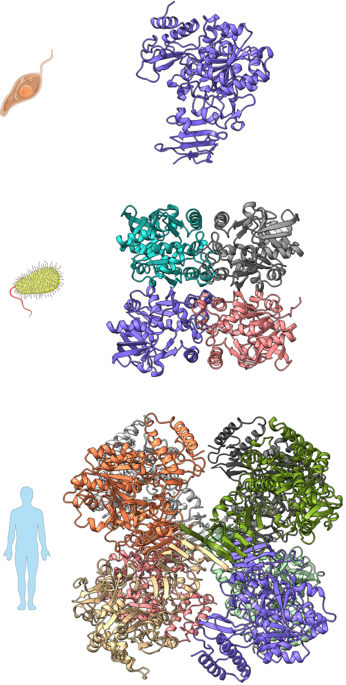Research

Our group aims at a detailed characterization of the enzyme UDP-glucose pyrophosphorylase (UGP), a candidate drug target, from pathogenic species and the human host to identify structural and/or mechanistic differences that would allow the development of specific inhibitors targeting UGP as a novel anti-infective drug target.
We have previously studied UGP from the protozoan parasite Leishmania major and the fungus Aspergillus nidulans. Our current work is focused on bacterial UGPs, because the ongoing development of anti-bacterial resistance is one of the greatest current threats to global health and raises an urgent need for new anti-bacterial drugs. Pathogenic bacteria utilize various capsular polysaccharides, lipopolysaccharides and exopolysaccharides for attachment and invasion of host cells, evasion of the host immune system and protection from hostile environments. Prerequisite for the synthesis of all these glycans is the enzymatic activation of monosaccharides into nucleotide sugars. The enzyme UDP-glucose pyrophosphorylase (UGP) catalyzes the synthesis of UDP-glucose, which in turn gives rise to further UDP-activated sugars, all of which are involved in the assembly of virulence-relevant bacterial glycans.
We employ typical biochemical and molecular biological methods including recombinant protein production, site-directed mutagenesis, electrophoresis, liquid chromatography and in vitro enzyme activity assays. In collaboration with local and international research partners, we conduct in vitro and ex vivo infection studies, investigate protein structures by X-ray crystallography and CryoEM, and perform in silico docking of compound libraries to identify UGP inhibitor candidates.
Image: Crystal structures of mono-, tetra- and octameric UGPs from the protozoan parasite Leishmania major, the bacterial pathogen Pseudomonas aeruginosa, and human (Homo sapiens). PDB IDs: 4M2A , 8F73 and 4R7P. Images generated with UCSF ChimeraX. Schemes of organisms from Servier Medical Art, provided by Servier, licensed under a Creative Commons Attribution 3.0 Unported License (https://creativecommons.org/licenses/by/3.0/).